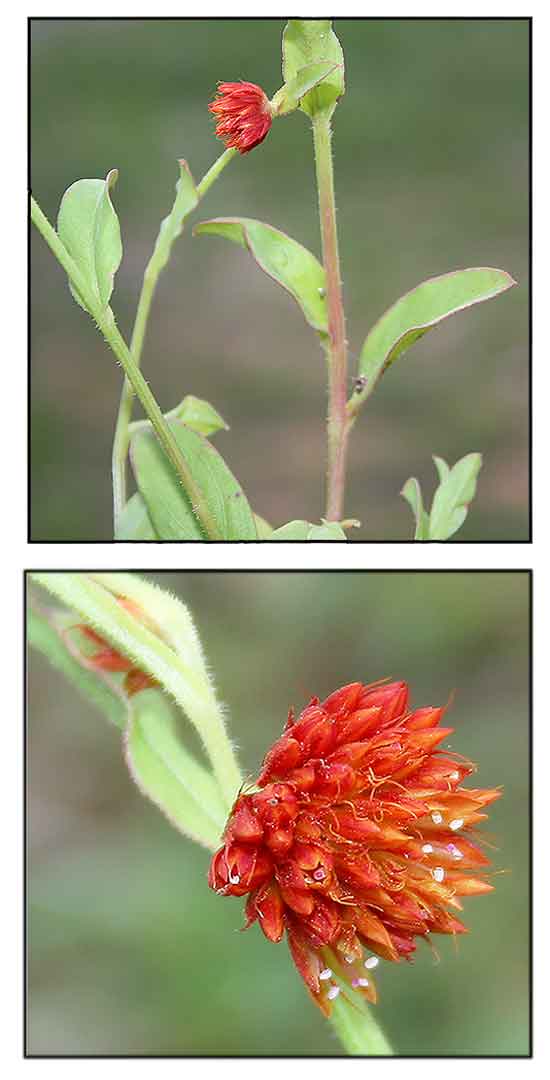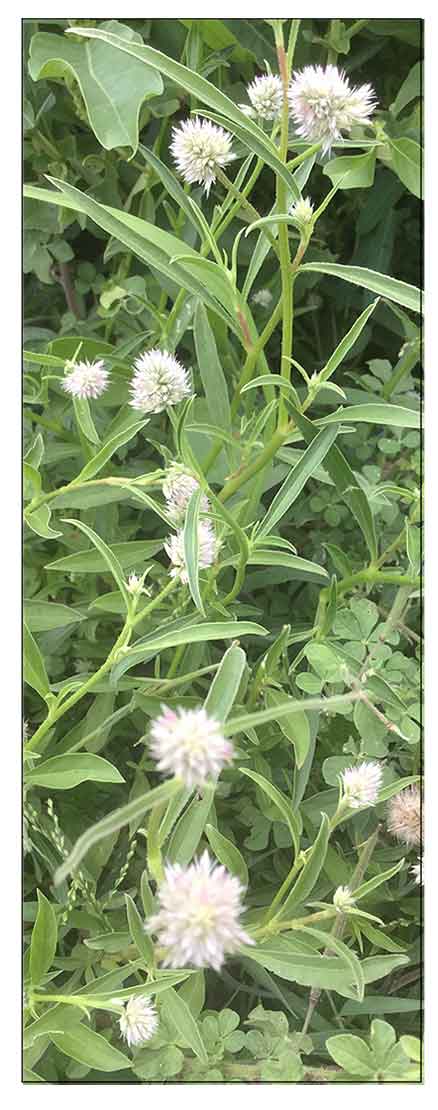 Gen info Gen info
- Allmania is a genus of flowering plants in the family Amaranthaceae. Allmania nodiflora used to be the lone Allmania species. Allmania multiflora is only the second species identified in the genus so far. It differs from having a higher number of florets within an inflorescence. (2)
Botany
• Herbs annual, erect or ascending, 10-50 cm tall. Stem branched from or near base, glabrous or obscurely pubescent. Petiole 2-10 mm; leaf blade obovate, oblong, or linear, 1.5-6.5 mm × 0.3-2.5 cm, both surfaces glabrous or adaxially pubescent, base attenuate, apex acute or obtuse, with a mucro. Heads globose, becoming somewhat lengthened, with 3-7-flowered cymes; rachis 0.2-3.5 cm, glabrous or pubescent. Bracts and bracteoles ovate-lanceolate, 3-5 mm, white on margin and with green or purple (?red) midvein, apex long acuminate. Tepals obliquely spreading at anthesis, later erect, ovate-lanceolate or oblong-lanceolate, 4-5 mm. Stamens 5; filaments connate at base. Ovary ovoid, glabrous; style nearly as long as filaments. Utricles enclosed in persistent perianth, pale green, ovoid, 3-3.5 mm in diam., dehiscent by lid. Seeds 1.5-2 mm in diam. (Flora of China)
• Diffuse herbs, stem puberulus. Leaves alternate, 2-6 x 1-1.5 cm, elliptic-oblong, apex acute, entire, glabrous. Flowers in terminal and axillary globose congested cymes, pedicelled; bracts and bracteoles 4 mm long, lanceolate, acuminate with filiform tips; tepals 5, equal, 5 x 1 mm, lanceolate, acute, free to the base, 1-nerved, glabrous; stamens 5, filaments united below into a membranous cup, glabrous; ovary obovoid, 1-celled, 1-ovuled, style 1, slender, stigma 2-toothed. Achenes 3 x 2 mm, ellipsoid with a long beak, biconvex, black. (India Biodiversity Portal)
Distribution
- Native to the Philippines.
- Also native to Assam, Borneo, China Southeast, East Himalaya, Hainan, India, Jawa, Laos, Lesser Sunda Is., Malaya, Sri Lanka, Sumatera, Thailand, Vietnam. (1)
- A common weed on light, especially sandy soils, sandy shores, fields, roadsides, and dunes; at elevations up to 100 m.
 Constituents Constituents
- Ethyl acetate and methanol extracts yielded total phenolics (21.91 and 21.71 µg/ml), total flavonoid (45.29 and 41.67 µg/ml), carbohydrate 89.50 and 82.14) and protein 18.29 and 17.99), respectively. (see study below) (3)
- Phytochemical screening of leaves yielded alkaloids, carbohydrates, glycosides, flavonoids, saponins, tannins, and steroids. (see study below) (8)
- Preliminary phytochemical analysis of petroleum ether and ethanol extracts of powdered leaves yielded alkaloids, flavanoid, saponins, glycosides, steroids, with absence of phenols. Tannins were also present in the ethanol extract. (see study below) (9)
- In a study of leaves of 30 freshwater aquatic plants conducted on extraction of protein from leaves, Allmania nodiflora showed highest content of crude protein (62.7%) and beta-carotene (7 82.4 micrograms/g). (10)
- Study of fresh and cooked leaves yielded 67 µg/g and 58 µg/g for lutein and 45 µg/g and 40 µg/g for ß-carotene. (12)
Properties
- Studies have suggest antioxidant, antidiabetic, antihyperlipidemic, α-amylase and α-glucosidase inhibitory, anti-inflammatory, antimicrobial, mosquito larvicidal, analgesic, CNS depressant properties.
Parts used
Leaves, fruits.
Uses
Edibility
- Leaves cooked, eaten as vegetable.
- Leaves and young shoots cooked with salt and chili, garnished with mustard seeds, curry leaves and onions in oil. (11)
Folkloric
- No reported folkloric medicinal use in the Philippines.
- In Tamilnadu, India, ripe fruits use to treat constipation and dysentery. Leaves used for fever. (14)
Studies
• Antioxidant: Study evaluated antioxidant activity and constituents of various extracts of Allamania nodiflora. The methanol extract exhibited significant antioxidant activity by DPPH radical scavenging and reducing power assays. Ethyl acetate extract was the richest source of flavonoids (45.29%) and equal amounts of phenols in both ethyl acetate and methanol extract (21.91%). The activity was attributed to marked amount of total phenolic and total flavonoid. (see constituents above) (3)
• Antioxidant / Anti-Lipid Peroxidation / Leaves: Study evaluated the phytochemical composition of water and ethanol extracts. Both extracts showed high amount of total antioxidant capacity (TAC) and dose-dependent activity against antioxidant assays. Comparatively, the water extract showed higher amounts of TPC, TFC, and TAC, and strongly inhibited DPPH, hydroxyl radical and ferric chloride-induced lipid peroxidation in goat liver tissue homogenate. Results suggest leaves as a potential source of natural antioxidants. (4)
• AN-1 / Antidiabetic / Antihyperlipidemic / Leaves: Study evaluated the effect of active fractions of A. nodiflora leaves on lipid and glucose profiles in normal and STZ-induced diabetic rats. Ethanolic leaf extract was give orally in doses of 200 and 00 mg/kg p.o. Metformin was used as standard. Column chromatography isolated an active compound, AN-1. AN-1 (100 mg/kg) significantly (p<0.05) decreased fasting blood glucose levels along with lowering of cholesterol and triglycerides and raising of HDL levels. Results suggest AN-1 has anti-diabetic and anti-hyperlipidemic activity. (5)
• α-Amylase and α-Glucosidase Inhibition / Polyphenols: Study evaluated the bioaccessibility and impact of in-vitro simulated digestion on polyphenolics identified by LC-MS. Although in vitro digestion reduced polyphenolics, the pancreatic digested sample showed significant 97% bioaccessibility with better metal ion binding activity (99%). Increased α-amylase and α-glucosidase inhibition (>45%) potentials were observed in the digested samples. Enzyme inhibition against postprandial hyperglycemia was attributed to presence of compounds viz. rutin, caffeic acid, catechin, saikosaponin. Results suggest A. nodiflora leaf could serve as functional food with the therapeutic potential of its assimilated polyphenolics and potential of a future nutraceutical development from green leafy vegetables. (6)
• Anti-Inflammatory / Antimicrobial / Antioxidant / Whole Plant: Study evaluated an ethanolic extract of whole plant for antioxidant, antimicrobial, and anti-inflammatory activity. Extract showed significant antioxidant activity by DPPH assay, Superoxide Radical, and Hydroxyl radical scavenging activity compared to ascorbic acid. Extract at 100 and 250 mg/kg exhibited significant and dose dependent anti-inflammatory activity by carrageenan induced rat paw edema method. Antimicrobial activity was evaluated against clinically important bacterial and fungal strains using cup plate method. (7)
• Antidiabetic / Leaves: Study evaluated the antidiabetic activity of ethanolic extract of leaves of A. nodiflora against streptozotocin-induced hyperglycemia in Wistar albino rats, using doses of 100, 200, and 400 mg/kg for 21 days. Glibenclamide was used as standard. Results showed the leaf extract possesses antidiabetic activity with dose dependent reduction in fasting blood glucose levels. The hypoglycemic mechanism may involve the potentiation of insulin action in the plasma, mediated by either increased pancreatic insulin secretion or enhanced release of insulin from a bound form. (8)
• Acute Toxicity Testing: Acute toxicity testing in mice of A. nodiflora ethanolic extract of leaves using doses of 5, 50, 300, and 2000 mg/kg per OECD 423 guidelines produced no death or signs of toxicity even at dose of 2000 mg/kg. The dose of 2000 mg/kg is considered an LD50 cutoff value. (8)
• Mosquito Larvicidal Against Aedes aegypti: Study evaluated the larvicidal activity of petroleum ether and ethanol extracts of A. nodiflora leaves against Aedes aegypti using concentrations of 2, 4, 8, 10, 15, and 20%. The extracts exhibited a concentration dependent activity against mosquito larva. Highest mortality was observed after 96 hours in the ethanolic extract. (9)
• Amelioration of Blood Glucose / Effect on Insulin and Leptin Levels: In a study that evaluated the preventive and protective effects of bioactivity-guided fractions of A. nodiflora in STZ-rats fed with high-fat diet. Doses of 20 and 40 mg/kg were administered for 28 days. Treatment showed amelioration of elevated blood glucose, which correlated with changes in insulin and leptin levels. There was also dose-dependent decrease in total LDL, triglycerides, and VLDL levels, indicating protective effects of bioactive fractions. (13)
• Analgesic, Anti-Inflammatory, CNS Depressant: Study evaluated an ethanolic extract of Allmania longipedunculata whole plant for analgesic, anti-inflammatory and CNS depressant activity in Swiss albino mice. The extract at dose of 200 mg/kg showed analgesic activity by Eddy's hot plate method, anti-inflammatory activity by formalin method, and central nervous system depressant activity by Actophotometer method. (15)
Availability
Wild-crafted.
|

![]()



 Gen info
Gen info
